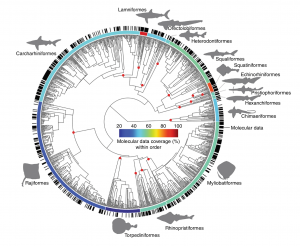The EDGE Sharks and Rays list includes many amazing members of a truly ancient fish taxa, the Chondrichthyes. From the highly camouflaged to the biggest in the ocean, these EDGE fishes are remarkable in the ways they catch prey, the ways they produce offspring and in the variety of shapes and sizes they have become.
Sharks and their relatives, the rays and chimaeras, are collectively known as Chondrichthyes. They are estimated to have lived in the world’s oceans for more than 400 million years. The species that remain in our waters today, many of which are living fossils, belong to groups that first appeared ~250 million years ago. The largetooth sawfish, at the top of the EDGE Sharks and Rays list, has the highest EDGE score of all vertebrates currently assessed.
They are a diverse group of fishes with a cartilaginous skeleton that gives them flexibility and buoyancy. Species from this group have successfully adapted to almost all aquatic ecosystems, from lakes and rivers to the deep sea, including estuaries, coastal lagoons and coral reefs.

Sadly, these highly evolutionarily distinct species are also highly threatened. These fish have been used for centuries as a source of protein, oil and desirable artefacts including leather (“Shagreen”) or even ceremonial weapons. They still have great economic and cultural importance.
Many of the threats sharks and rays face include targeted fisheries and being unintentionally caught (bycatch). Due to the lack of proper management in many fisheries, many shark and ray species have suffered steep declines in the past decades. Habitat degradation, resulting from coastal development, deforestation, pollution and trawling, has also contributed to the bleak status of sharks and rays.
Although widely recognised, this group is poorly understood, and many species have only been discovered recently. In the first decade of the 21st century, about 15% of all recognized species were described for the first time. The life history of many remains unknown. This lack of information hinders the delivery of effective conservation and therefore more research is urgently needed.
The EDGE Sharks and Rays
Reflecting the greater diversity of species in the batoid group (rays), the list is overwhelmingly dominated by rays, specifically stingrays (Dasyatidae), eagle rays (Myliobatidae) and guitarfishes (Rhinobatidae). On the shark side, most EDGE species are houndsharks, catsharks and requiem sharks, collectively known as ground sharks (order Carcharhiniformes). This is the largest order of sharks, all of which have five gill slits and a third, translucent eyelid called the nictitating membrane. Only one species of chimaera, the Ogilby’s Ghostshark, is on the EDGE list. Although chimaeras separated from their common ancestor many years earlier than sharks or rays, many species lack sufficient information to assess their extinction risk, and therefore an EDGE score cannot be calculated.
The top 50 EDGE Sharks and Rays includes 11 of the 13 living orders of sharks and rays. It also holds two species which are the only extant representatives of their families, the Whale shark (Rhincodon typus) and the Zebra shark (Stegostoma fasciatum). The top EDGE Sharks and Rays List reflects the dire situation of the family Pristidae, the sawfish, as all 5 species appear among the top 10 on the list.
The EDGE Sharks and Rays list highlights the most Evolutionarily Distinct and Globally Endangered species of Chondrichthyes around the world. The list provides another important tool to focus conservation action where it is most needed.
Click here to explore the Top 50 EDGE Sharks and Rays List.
Click here for the latest EDGE Sharks and Rays List.
When creating our EDGE Sharks and Rays list, we follow the taxonomy of the World Register of Marine Species.
